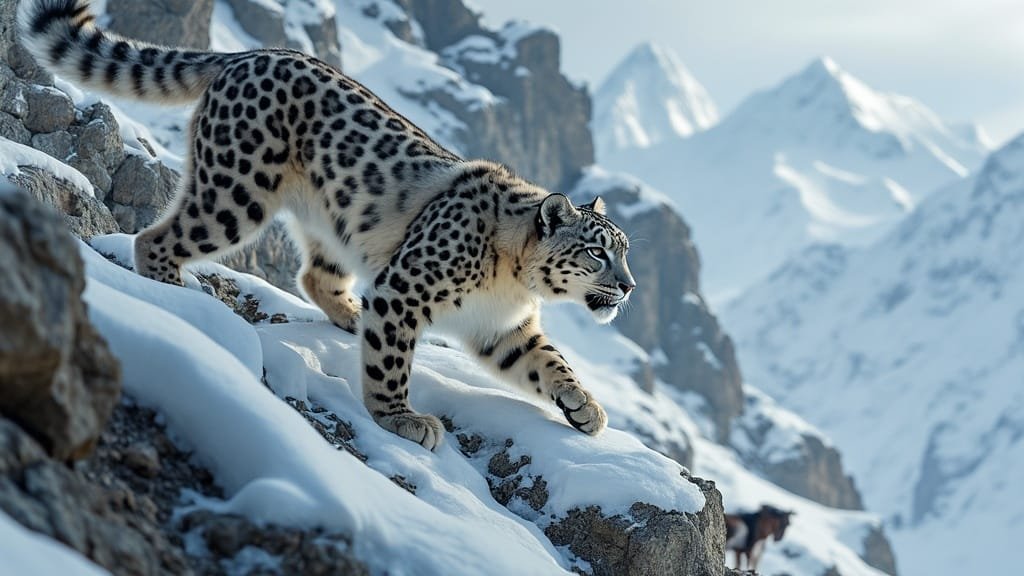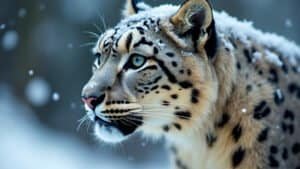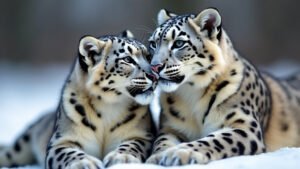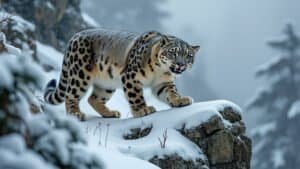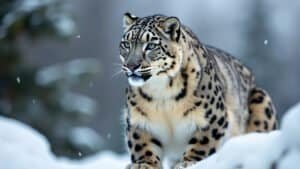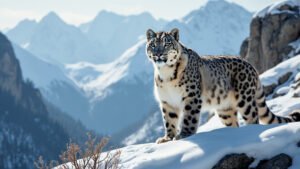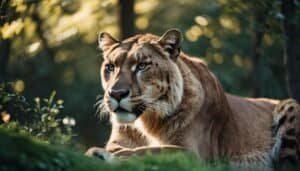Introduction
Snow leopards, known for their elusive nature and remarkable hunting skills, thrive in some of the most challenging environments on Earth. Their survival and predatory success in the cold, high-altitude ranges of Central Asia are driven by unique genetic adaptations
These adaptations enable them to utilize oxygen efficiently, develop extraordinary muscle strength, and move with stealth and agility across rocky terrains
Additionally, specialized genes enhance their vision for low-light hunting, optimize energy metabolism for endurance, and refine sensory traits like smell to detect prey over vast distances
In this article, we will explore the genetic traits that underpin snow leopards’ remarkable hunting abilities. From their adaptations to high-altitude life to their stealth mechanisms and energy efficiency, each section delves into the fascinating genetic blueprints that make these big cats master predators in extreme conditions
Genetic Adaptations That Enhance Snow Leopards’ Hunting Abilities
Snow leopards are equipped with exceptional biological traits that make them formidable hunters in their harsh, high-altitude habitats
These adaptations are deeply rooted in their genetic code, influencing critical aspects such as oxygen utilization, muscle power, and stealth. By understanding these genetic traits, we gain insight into how snow leopards excel in ambush hunting amidst the challenges of snowy and rocky terrains
Oxygen Efficiency in High-Altitude Environments
Hunting at altitudes above 9,800 feet demands efficient oxygen utilization, a task snow leopards are genetically optimized for
Their ability to thrive in hypoxic conditions stems from mutations in genes like EPAS1 and EGLN1, which regulate the hypoxia-inducible factor (HIF) pathway. These genes allow their cells to adapt to reduced oxygen levels by enhancing oxygen transport and utilization efficiency
A study by Wang et al. (2016) revealed that these adaptations not only support basic survival but also enable extended physical exertion during hunts. The heightened efficiency in red blood cell production ensures that their muscles remain active and responsive, even during intense chases or when ambushing prey over steep slopes
This genetic mechanism mirrors adaptations seen in other high-altitude animals like the Tibetan antelope but is uniquely fine-tuned for a predator’s needs
Muscle Strength and Hunting Endurance
Muscle performance is a cornerstone of snow leopards’ hunting prowess
Genes such as ACTN3 are key contributors to the development of fast-twitch muscle fibers, allowing for explosive power during leaps and sprints. This gene is often referred to as the “speed gene” and is critical for rapid movements required to ambush prey
Janecka et al. (2017) highlighted the importance of PPARGC1A, a gene that regulates energy metabolism in muscles. Its role in mitochondrial biogenesis ensures that muscle fibers remain fueled during prolonged exertion, such as stalking prey over several miles of rugged terrain
Moreover, adaptations in MYH7, which governs skeletal muscle structure, grant snow leopards the ability to leap vertically up to 50 feet, a feat critical for surprising prey from above
These genetic traits collectively enhance the snow leopard’s stamina and strength, making it a top predator in the unforgiving Himalayan and Central Asian landscapes
Stealth and Silent Movement Mechanisms
The element of surprise is pivotal in snow leopards’ hunting strategy, and their genes have evolved to support unparalleled stealth
Variations in BMP3 and COL1A1 genes influence their limb structure, providing the flexibility and strength needed for silent, agile movements. Snow leopards’ long hind legs and cushioned paw pads, influenced by keratin-related genes such as KRT5, allow them to absorb sound when moving across snow or rocky surfaces
Meachen and Samuels (2020) noted that these adaptations are further supported by genetic modifications affecting fur texture and coloration, which help snow leopards blend seamlessly into their surroundings
This camouflage minimizes detection by both prey and competitors, giving the snow leopard an upper hand in the final moments of an ambush
Vision Optimization for Low-Light Hunting
Snow leopards are crepuscular hunters, meaning they are most active during dawn and dusk
This behavior is supported by genetic adaptations in the RHO gene, which enhances rod photoreceptor sensitivity for improved low-light vision. Another gene, OPN1LW, contributes to advanced depth perception, crucial for judging distances accurately while leaping toward prey
Li et al. (2020) emphasized how these genetic traits are tailored for predatory needs, allowing snow leopards to spot and track prey even under dim conditions common in snowy environments
This sharp visual acuity is one of the reasons why snow leopards are so adept at ambushing prey from a distance or tracking movement in challenging terrains
Camouflage and Fur Adaptations
Snow leopards’ coats, marked with distinctive rosettes, serve both as camouflage and insulation against the freezing cold. The FGF5 gene regulates the density and length of their fur, ensuring they remain warm while remaining visually indistinguishable from the rocky landscapes they inhabit
Xu and Zhang (2022) identified specific genetic pathways that control the unique pattern of their coat, which breaks up their outline against the snowy and rocky background
This dual-purpose adaptation of warmth and stealth enhances their ability to close the distance to prey undetected, securing their position as apex hunters of their habitat
Energy and Metabolic Traits Supporting Hunting Success
Snow leopards must balance their energy needs with the scarcity of prey in their high-altitude habitats. Their genetic adaptations for efficient energy use and cold resilience ensure they can endure long hunting sessions and survive in environments where food is often hard to come by
These traits, encoded in their DNA, are key to their survival and dominance as predators in extreme conditions
Mitochondrial Adaptations for Cold Hunting
Hunting in sub-zero temperatures requires an efficient energy system capable of generating heat without depleting the body’s reserves. Snow leopards have mitochondrial DNA variants that optimize heat production and energy efficiency
These adaptations, found in genes regulating oxidative phosphorylation pathways, ensure that their cells generate sufficient energy to maintain body temperature and muscle performance during long hunts
Li et al. (2020) emphasized the role of these genetic traits in allowing snow leopards to function effectively in freezing conditions. By minimizing energy loss and maximizing heat retention, these adaptations enable them to conserve resources, making them exceptionally well-suited to harsh, mountainous terrains
Energy Efficiency in Low-Prey Environments
Snow leopards’ ability to thrive in prey-scarce environments stems from adaptations in the PPARGC1A gene, which regulates mitochondrial biogenesis and energy metabolism. These genetic changes enhance the efficiency of ATP production, allowing snow leopards to sustain activity over extended periods without frequent feeding
Janecka et al. (2017) observed that this metabolic efficiency is a key survival strategy in habitats where large prey can be spread out over vast distances. By optimizing their energy reserves, snow leopards can afford to spend significant time and effort stalking and chasing prey without risking starvation
Genes Linked to Long-Distance Stamina
Long hunting expeditions across rugged terrains require exceptional stamina, which is supported by genetic adaptations in snow leopards
Genes such as UCP1, associated with thermogenesis in brown fat tissue, help generate additional energy during prolonged activity. Similarly, PPARA and CPT1A genes play roles in fat metabolism, allowing snow leopards to use fat as a long-lasting energy source during extended hunts
These adaptations reduce the need for frequent feeding and support the snow leopard’s ability to cover great distances while tracking elusive prey
Xu and Zhang (2022) highlighted these genetic traits as instrumental in maintaining the snow leopard’s position as a top predator despite the challenges of their environment
Sensory and Skeletal Enhancements for Predation
Snow leopards possess finely tuned sensory and skeletal adaptations that give them an edge in detecting, stalking, and capturing prey
These traits, rooted in their genetic makeup, ensure that they excel in their role as apex predators of their environment. From heightened olfactory capabilities to powerful leaps and silent movements, their genetic toolkit is a testament to evolutionary specialization
Advanced Olfactory Adaptations
Snow leopards’ acute sense of smell is critical for locating prey in the vast, rugged terrains they inhabit
Variants in olfactory receptor genes, particularly OR6A2, enhance their ability to detect prey from great distances, even when prey is hidden by snow or dense terrain. This genetic adaptation compensates for the scarcity of prey and increases their chances of successful hunts
Xu and Zhang (2022) found that snow leopards’ olfactory receptors are among the most specialized in the Panthera genus, allowing them to track faint scent trails over long distances
This heightened olfactory capacity not only aids in hunting but also plays a role in territorial marking and mate selection, making it a multifunctional adaptation
Genetic Contributions to Powerful Leaps
Snow leopards’ incredible leaping abilities are a result of skeletal muscle adaptations influenced by genes like MYH7 and TTN
These genes regulate the structure and elasticity of muscle fibers, enabling snow leopards to leap up to 50 feet horizontally or vertically. This power is essential for ambushing prey on steep cliffs or rocky ledges, where their prey often resides
Wang et al. (2016) highlighted how these genetic traits not only provide the explosive strength necessary for such jumps but also ensure durability, preventing injuries during high-impact landings
This capability to leap significant distances in a single bound gives snow leopards a strategic advantage in their challenging terrain
Specialized Paw Pads for Silent Stalking
Silent movement is vital for predators relying on ambush strategies, and snow leopards have evolved specialized paw pads to support this need
Genetic modifications in keratin-related genes, such as KRT5, have resulted in soft yet durable paw pads that absorb sound while traversing snow or rocky surfaces
Meachen and Samuels (2020) noted that these pads, combined with retractable claws, allow snow leopards to move stealthily without alerting prey
This adaptation is particularly effective in icy or uneven terrains, where sound can travel quickly. These specialized paws are also adapted to grip slippery surfaces, giving snow leopards exceptional balance and precision during a hunt
Conclusion
Snow leopards are a marvel of evolutionary adaptation, with their genetic traits finely tuned to overcome the challenges of high-altitude, frigid environments
Their hunting abilities are supported by efficient oxygen utilization, powerful muscles, and stealth-enhancing traits such as specialized paw pads and limb morphology. Advanced vision genes allow them to hunt effectively in low-light conditions, while their metabolic adaptations ensure they thrive in prey-scarce, energy-demanding habitats
These genetic blueprints not only define their success as apex predators but also highlight the intricate relationship between an animal and its environment
As research continues, understanding these adaptations may provide insights into conservation strategies, ensuring the survival of these elusive big cats in an increasingly fragile ecosystem
